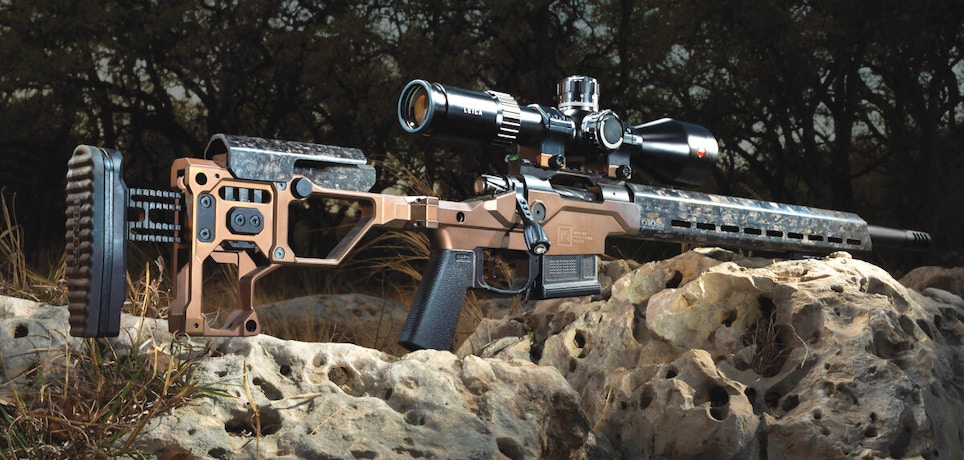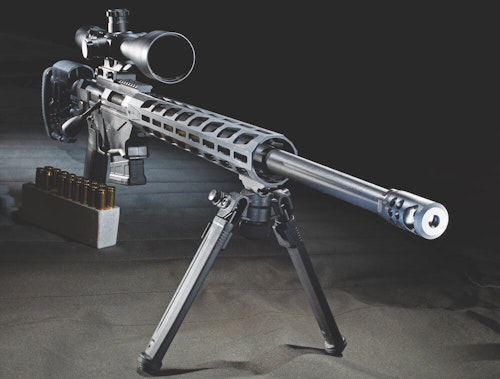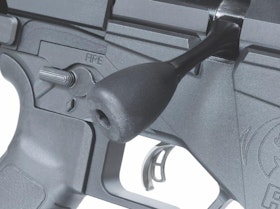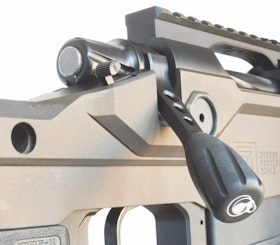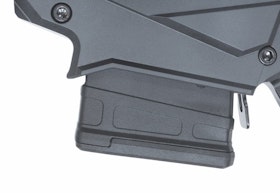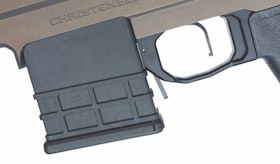Bolt-action rifles shine when distances stretch and solid rests, meditative calm and precision are mandatory. The Christensen Arms Modern Precision Rifle and Ruger’s Precision Rifle are very different guns, but they both stack up quite well against these challenges.
How well the Christensen Arms Modern Precision Rifle (MPR) delivers straight out of the box is jaw-dropping, displaying an uncanny ability to print tiny groups that rival or exceed high-priced custom bolt actions. Ruger’s Precision Rifle is equally impressive and lives up to the company’s hard-earned reputation for quality and solid build.
But despite the shared performance and identical methods of operation, the rifle designs are light years apart. One’s finely tuned for moving, the other a solid platform that shines brightest when working from a blind or stationary firing line. Both do yeoman’s duty in either situation, but a comparison of features highlights their distinct differences.
The Precision Rifle shipped for review from Ruger was chambered in 6.5 Creedmoor. Christensen Arms sent a .223 Rem. MPR. Barrel lengths were 20 and 24 inches, respectively. For the sake of an apples-to-apples comparison, A Christensen MPR chambered in 6.5 Creedmoor weighs roughly 7.8 pounds, while the Ruger comes in at 10.7 pounds. Those 3 pounds are a significant difference if you’re on the move, although it’s a benefit when you need a solid rest. The MPR is also roughly 2 inches shorter than the Ruger Precision in the same barrel length and chambering. Both stocks are folding, but even those mechanisms differ between companies, regardless of chambering.
Like everything Ruger, the folding hinge is overbuilt to take a beating for decades without fail. Collapsed it holds firmly to the left of the receiver — the non-bolt-handle side. The MPR mechanism, on the other hand, is stout, but much more streamlined. It swings to the right, but the stock’s clever design prevents it from damaging the bolt handle if the gun is in battery. Once collapsed it’s convincingly held in that position by Magnelock technology.
Bolts and Safety
To remove the Ruger Precision Rifle’s three-lug, 70-degree-throw bolt, which has a nitride finish for durability, the stock must fold. Christensen’s bolt can come out regardless of stock position and it’s also nitride treated. The latter’s spiral fluting and skeletonized handle, however, set the twin-lug bolt — with AR-15-style extractor — cosmetically apart from Ruger’s.
Both handles are oversized to ease gloved or sweaty-palm operation. Christensen’s is admittedly smaller, but grooves across its surface make up for the difference and add to the look. Ruger’s Precision Rifle features an ambidextrous safety, located directly above the pistol grip. It’s a familiar configuration for AR owners. Christensen’s is in the traditional bolt-action spot, top right rear of the rifle action.
Significant Trigger Differences
Both triggers were a pleasure. Breaks were crisp, clean and there was no discernable creep. There are significant differences between their designs and function, though.
The average let-off weight of the tested MPR’s Trigger Tech flat trigger — a single-stage version — came in at 2.3 pounds. There is no simple way for owners to adjust that figure. Ruger’s Precision Rifle wears the company’s famed Marksman adjustable trigger and that now-familiar double-paddle look. The review rifle’s average let-off weight hovered slightly less than 3 pounds, but owners can tune that setting to anywhere from 2.25 to 5 pounds. The wrench to get it done cleverly stores in the gun’s bolt shroud — and we’ve all misplaced tiny tools like that before.
Construction Comparison
An all-aluminum chassis is a common thread between the two, but Christensen trims weight by using aerospace-grade carbon fiber in the handguard/fore-end. It even wraps the barrel in the material, an approach harnessed to improve barrel heat transfer and maintain shot-to-shot consistency. It’s a nice look, comfortable to the touch and lightens the load.
Ruger, on the other hand, adheres to its rugged build mission by sticking with aluminum in the fore-end. M-Lok slots for accessory mounting on the 3-, 6- and 9-o’clock positions are another common thread in the guns, but the Precision Rifle also has them on top, where the MPR has small heat-dissipating holes.
Magazines and Customization
Both models have drop magazines, with the MPR using AICS-compatible versions. Ruger’s versatile design, however, allows it to run AICS mags, their clones and a variety of common Magpul designs. The release lever is directly in front of the trigger guard in these guns.
Pistol grips on either firearm are replaceable with most AR versions, adding some room for customization, but Ruger takes things a step further. The stock on its Precision Rifle attaches to a standard AR buffer tube, which means owners can replace it with a favorite aftermarket model quickly and easily.
Odds are good that enthusiasts won’t feel the urge to do so once they witness the features packed into the one that ships on the Precision Rifle. The cheekpiece and length of pull are fully adjustable, and an overbuilt locking-lever system holds things in place with authority. Plus, there’s a QD slot on both sides, a generous recoil pad and bottom Picatinny rail for those long shots that require serious anchoring.
Christensen’s MPR stock isn’t swappable, but like the Ruger version comes with all the right features. It has four QD sling mounts, wears a Limbsaver recoil pad and is also adjustable for length of pull and cheek-piece height.
Despite the notable differences, the rifles have all the critical ingredients in common. The fact they print tiny groups at distance, despite being fresh from the factory and not broken in, is foremost among them.
Long-Distance Accuracy
Last year, I spent nearly a week behind a 6.5 Creedmoor-chambered MPR shooting long distance targets in Texas. The performance was exceptional, with two skilled shooters using it to connect on steel at 1 mile. Those hits were not regular, thanks partly to the wind gusts, but after reeling things in to 1,000 yards, the “clangs” became routine — even with my unpolished technique.
Both evaluation models also spent time punching paper from a sandbagged rest at 100 yards. To determine their preference, if there was any, three different loads were fed to each gun.
The MPR’s three-shot groups were consistent at anywhere between 0.6- and 0.9-inch, regardless of bullet weight or design. It’s not a finicky eater. If you’re looking for squeaky groups, consider starting with American Eagle’s 62-grain FMJ load. It printed one group that came in just below half an inch. Several others came close afterward, but were unable to equal that mark.
The Ruger was a little pickier when it came to loads. Norma Match 130-grain HPBTs printed the best group at just over half an inch. Things widened as bullet weight increased, but never crossed the MOA mark.
It’s always wise to try different bullet weights and profiles to identify that pet load. And with either of these rifles you won’t complain about long-range sessions either.
Reasonable Recoil
Despite the MPR’s light weight, shooting the .223 Rem.-chambered model was more akin to getting behind a rimfire than centerfire. The gun was back on target lightning fast. The rifle’s muzzle brake — finely tunable by backing out one or all four of the set screws atop the unit — does a lot of that work. Admittedly, the small cartridge doesn’t pack a lot of perceived recoil punch, but even after days behind the 6.5 Creedmoor version in Texas complaints focused on the hours in the prone position rather than shoulder discomfort. That says a lot about the muzzle device’s effectiveness.
Perceived recoil with the 6.5 Creedmoor Ruger was about the same as I experienced in the Lone Star State, perhaps less. What was more surprising, though, was the noise. Most brakes make any gun uncomfortably loud for someone next to you on the firing line, so I warned neighbors the day I tested. According to what I was told afterward, the Ruger Precision Rifle Hybrid Muzzle Brake the rifle wears lives up to the company’s claim that it also minimizes “… noise and blast to the sides of the shooter.” That’s a nice bonus, especially if you hunt with a friend or loved one.
Optics, Reliability and Parting Thoughts
Both rifles ship with a 20 MOA Picatinny rail on the receiver for optics mounting. It’s another nice touch when long-range shooting/hunting is on the agenda. There were no failures to feed or stoppages during testing. Inserting magazines in the Ruger was clunky at first, but sped up steadily as the shooting day wore into the evening. That’s a new gun thing, along with user unfamiliarity.
Both rifles provide the kind of performance that’s scarce today — built to last and wear all the right features to connect at long distance with minimal fuss and muss.
